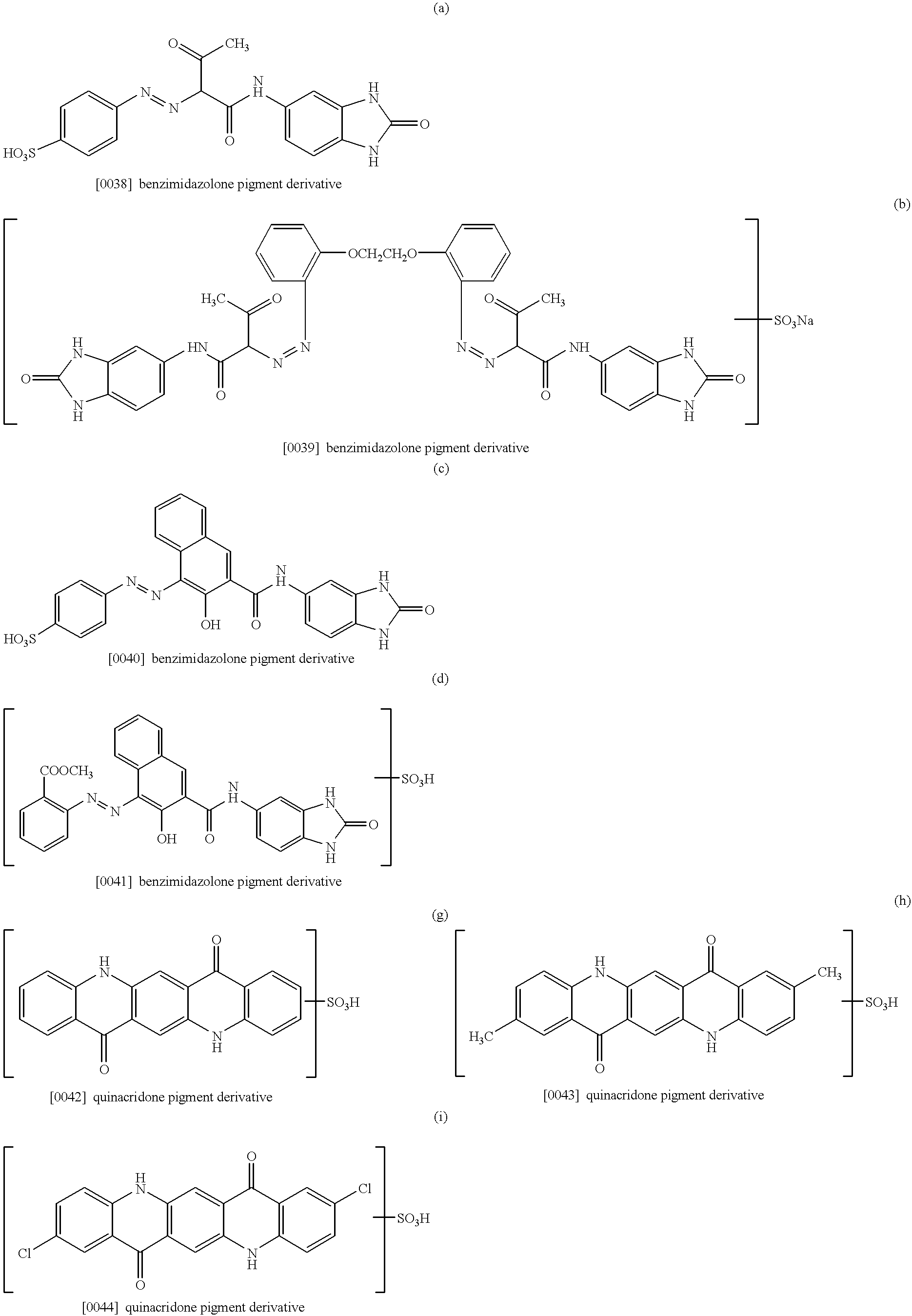Water-based pigment dispersion, use thereof and process for the production thereof
a technology of pigment dispersion and water-based pigment, which is applied in the field of water-based pigment dispersion, use thereof and process for the production of such pigment, can solve the problems of foaming of surfactant, reduced leveling properties, and limited effect of dispersing resin on pigment dispersion, and achieves low conductivity, high surface tension, and high dispersibility.
- Summary
- Abstract
- Description
- Claims
- Application Information
AI Technical Summary
Benefits of technology
Problems solved by technology
Method used
Image
Examples
example 1
[0136] (Benzimidazolone Pigment) (Preparation of a Pigment Dispersion (a'))
[0137] 8.0 parts by weight of sodium hydroxide was dissolved in 200 part of deionized water, and 17.3 parts of 4-aminobenzensulfonic acid was added. 50 parts of concentrated hydrochloric acid was added to the resultant solution, and the mixture was cooled to 0.degree. C. or less. Then, 7.2 parts of sodium nitrite was dissolved in 20 parts of deionized water, the mixture was dropwise added to a reaction system, and the resultant mixture was stirred for 1 hour at 5.degree. C. or less. Then, 10.4 parts of sodium hydroxide was dissolved in 1,000 part of deionized water, and 23.3 parts of acetoacetylbenzimidazole was added. 25.5 parts or 85% by weight acetic acid was added thereto. To the resultant solution was dropwise added the diazonium salt solution prepared above, and the mixture was stirred for 1 hour at room temperature. A precipitate was filtrated and washed with deionized water to obtain 210 parts of an a...
example 2
[0142] (Benzimidazolone Pigment) (Preparation of a Pigment Derivative (b'))
[0143] 50 parts of C.I. pigment yellow 180 was added to 750 parts of 95% by weight sulfuric acid at 10.degree. C. or lower. Then, the temperature was increased to 15.degree. C., and the mixture was stirred for 2 hours at 15.degree. C., and then the mixture was poured into ice water, to obtain a precipitate. The precipitate was filtered and washed with 5% by weight common salt water, to obtain 294 parts of an aqueous paste of a sulfonated pigment (53 parts when dried). In the sulfonated pigment, the n=1 (compound having one sulfonic acid group) content ratio was 90%, the n=2 (compound having two sulfonic acid groups) content ratio was 8%, and the rest was a non-substitution product.
[0144] Then, the aqueous paste of the pigment derivative was re-slurried with deionized water to prepare a 1% by weight aqueous dispersion. The above aqueous dispersion was desalted and washed with an ultrafilter ("Centramate", supp...
example 3
[0148] (Benzimidazolone Pigment) (Preparation of a Pigment Derivative (c))
[0149] An aqueous paste of a pigment derivative (c) was obtained in the same manner as in Example 1 except that 23.3 parts of the acetoacetylbenzimidazole was replaced with equimolar amount (33.8 parts) of 3-hydroxy-N-(2-oxo-5-benzimidazolinyl)-2-naphthoamide.
[0150] Then, the procedures for desalting and washing were carried out in the same manner as in Example 1, to decrease the content of metal ions having a valence of at least 2 from 680 ppm to 610 ppm. The resultant material was dried, whereby a pigment derivative (c) was obtained. In the pigment derivative (c), the n=1 (compound having one sulfonic acid group) content ratio was 100%.
[0151] (Preparation of a Water-Based Pigment Dispersion)
[0152] 20 g of C.I. pigment red 171 having an average primary particle diameter of 90 nm (in which the content of metal ions having a valence of at least 2 was 380 ppm), 4 g of the pigment derivative (c) and 110 g of deio...
PUM
| Property | Measurement | Unit |
|---|---|---|
| average primary particle diameter | aaaaa | aaaaa |
| particle diameter | aaaaa | aaaaa |
| particle diameter | aaaaa | aaaaa |
Abstract
Description
Claims
Application Information
 Login to View More
Login to View More - R&D
- Intellectual Property
- Life Sciences
- Materials
- Tech Scout
- Unparalleled Data Quality
- Higher Quality Content
- 60% Fewer Hallucinations
Browse by: Latest US Patents, China's latest patents, Technical Efficacy Thesaurus, Application Domain, Technology Topic, Popular Technical Reports.
© 2025 PatSnap. All rights reserved.Legal|Privacy policy|Modern Slavery Act Transparency Statement|Sitemap|About US| Contact US: help@patsnap.com



